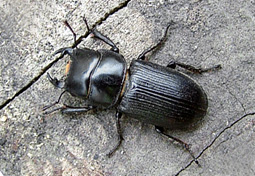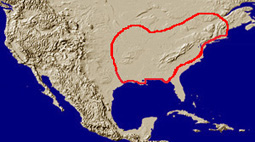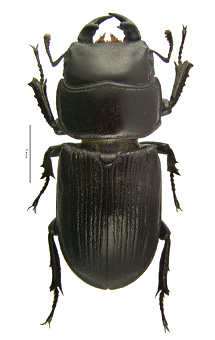 |
|||||||
|
|||||||
Dorcus parallelus (Say, 1823)
.....Lucanus parallelus Say, 1823: 248. (orig. comb.)
.....Lucanus voeti Schönherr, 1817: 326. (synonym)
.....Lucanus oblongus de Charpentier, 1825: 214. (synonym)
.....Dorcus costatus LeConte, 1866: 35. (synonym)
.....Dorcus carnochani Angell, 1916: 70. (synonym)
|
||
| Lucaninae Genera | ||
|
||
| Lucanidae Taxa Map | ||
| Lucanidae Catalog | ||
| Lucanidae Key | ||
| Lucanidae Gallery |
|
 |
Live D. parallelus, male. Photo by MJP. |
|
 |
|
D. parallelus Say, male. Photo by M.J. Paulsen |
|
Distribution: North America: Eastern US and Canada.
Ratcliffe, B.C. 1991. The Passalidae and Lucanidae (Insecta: Coleoptera) of Nebraska. Great Plains Research 1: 249-282.
Riley, E. G. and C. S. Wolfe. 2003. An annotated checklist of the Scarabaeoidea of Texas. Southwestern Entomologist, Supplement, no. 26. 37 pp.
Revision or Synopsis:
Benesh, B. 1937. Some notes on boreal American Dorcinae (Coleoptera: Lucanidae). Transactions of the American Entomological Society 63: 1-16 + pl. I-III.
Paulsen, MJ. 2010. Stag beetles of the genus Dorcus MacLeay in North America (Coleoptera, Lucanidae). In: Ratcliffe B, Krell F-T (Eds) Current advances in Scarabaeoidea research. ZooKeys 34: 199–207. Download.
Remarks:
This species and D. brevis are often confused. This species is usually darker and the body is more notably elongate. The male has a single large internal tooth on the mandibles. In contrast, D. brevis is generally lighter brown with a distinctly wider body and has two small internal teeth on the male mandibles (the largest males of D. brevis have only one tooth, but are quite distinct). The male genitalia of the two species are distinct.
|
||||
|
|
